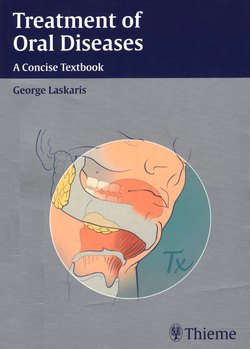Читать книгу Treatment of Oral Diseases - George Laskaris - Страница 27
ОглавлениеBullous Pemphigoid
Definition
Bullous pemphigoid is a chronic bullous disease primarily affecting the skin and. less often, the mucous membranes. It commonly affects middle-aged and elderly individuals.
Etiology
Bullous pemphigoid is an autoimmune disease. Bullous pemphigoid antigens 180 (BP180) and 230 (BP230) have been identified as the target antigens, and autoantibodies to these antigens are pathogenetically critical.
Main Clinical Features
The oral mucosa is affected in about 30-40% of cases and usually follows skin involvement. Bullous pemphigoid may rarely be associated with internal malignant disease.
Oral Mucosa
•Localized or scattered bullae that rupture leaving persistent painful erosions
•Palatal and buccal mucosa, tongue, lips, and gingiva are more frequently affected
•Rarely the oral lesions are the first manifestations
Other Mucosae
•Conjunctiva, esophagus, vagina, and anus are affected less frequently
Skin
•Nonspecific generalized rash and tense bullae, isolated or in dusters, that rupture leaving erosions without a tendency to extend peripherally
•Nikolsky sign is negative
Diagnosis
The clinical diagnosis should be confirmed by histopathologic examination and direct and indirect immunofluorescence. Circulating anti-basement membrane antibodies can be found in the sera of about 70-80% of patients.
Differential Diagnosis
•Pemphigus
•Cicatricial pemphigoid
•Linear IgA disease
•Pemphigoid gestationis
•Epidermolysis bullosa acquisita
•Dermatitis herpetiformis
•Erythema multiforme
•Stevens-Johnson syndrome
•Bullous and erosive lichen planus
•Bullous systemic lupus erythematosus
Treatment
Basic Guidelines
•Systemic and topical treatments should be used in the management of bullous pemphigoid depending on the severity of the disease. The age of the patient and the presence of other diseases should be also taken into consideration.
•Severe and moderate disease with oral lesions usually need systemic corticosteroids alone or in combination with immunosuppressives or dapsone.
•Localized mild disease with oral or skin lesions alone may initially be treated with local corticosteroids.
•The side effects of systemic corticosteroid therapy must always be taken into account and the patients should be regularly examined both clinically and by laboratory testing for this possibility.
•Patients with oral lesions should avoid mechanical injuries and should be advised to maintain good oral hygiene.
Suggested Therapies
Systemic Treatment
Oral Corticosteroids
Oral corticosteroids are (he mainstay of therapy for bullous pemphigoid. The majority of patients with generalized disease usually respond well to 40-80 mg/day of prednisone or prednisolone. It usually takes 2-3 weeks to stop new bullae formation and for old lesions to heal. Once the disease is controlled, the dose of the corticosteroid is tapered slowly over months and finally the drug is withdrawn. Recurrences are not unusual.
Immunosuppressive Drugs
Azathioprine 50-100 mg/day appears to be effective and it is the most commonly used corticosteroid-sparing agent for bullous pemphigoid. Cyclophosphamide 100-200 mg/day or cyclo-sporine 5-8 mg/kg per day also appears to be effective. Recently, mycophenolate mofetil 2 g/day has been used either in combination with corticosteroids or as monotherapy in the treatment of bullous pemphigoid with considerable success.
Dapsone/Sulfapyridine
Dapsone 50-100 mg/day or sulfapyridine 2-4 g/day might be effective in some cases (10-15%) of bullous pemphigoid, in particular in younger patients or patients with localized oral lesions.
Topical Treatment
Localized oral or skin lesions may be successfully treated with topical corticosteroids alone. This treatment may be given either in the form of oral paste or ointment, or in the form of an intra-lesional injection.
Alternative Therapies
•Tetracycline/niacinamide: Tetracycline 1.5-2.0 g/day alone or in combination with niacinamide 1.5 g/day are useful, particularly for controlling limited disease.
•Plasmapheresis: This can be used as an adjuvant to corticosteroids in selected severe cases of bullous pemphigoid.
•Future therapies of bullous pemphigoid might be directed toward the induction of compensating BP180 and BP230 isoforms.
•Topical use of tacrolimus in an adhesive paste form may also be useful for localized oral lesions.
References
Böhm M, Beissert S, Schwarz T, et al Bullous pemphigoid treated with mycophenolate mofetil. Lancet 1997, 349:541.
Grundmann-Kollmann M, Kaskel P, Leiter U, et al. Treatment of pemphigus vulgaris and bullous pemphigoid with mycophenolate mofetil monotherapy. Arch Dermatol 1999;135:724–725.
Joly P, Roujeau JC, Benichou J, et al. A comparison of oral and topical corticosteroids in patients with bullous pemphigoid. N Engl J Med 2002;346:321–327.
Korman NJ. New immunomodulating drugs in autoimmune blistering diseases. Dermatol Clin 2001;19:637–648.
Liu Z, Diaz LA. Bullous pemphigoid: End of the century overview. J Dermatol 2001;28:647–650.
Stern RS. Bullous pemphigoid therapy—think globally, act locally. N Engl J Med 2002;346:364–367.
Wojnarowska F, Kirtschig G, Khumalo N. Treatment of sub-epithelial immunobullous diseases. Clin Dermatol 2001;19:768–777.
